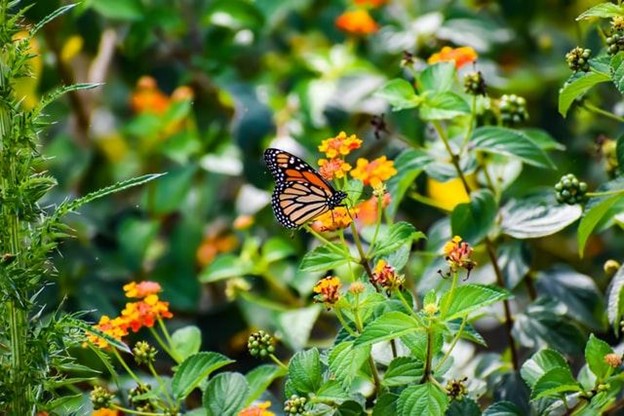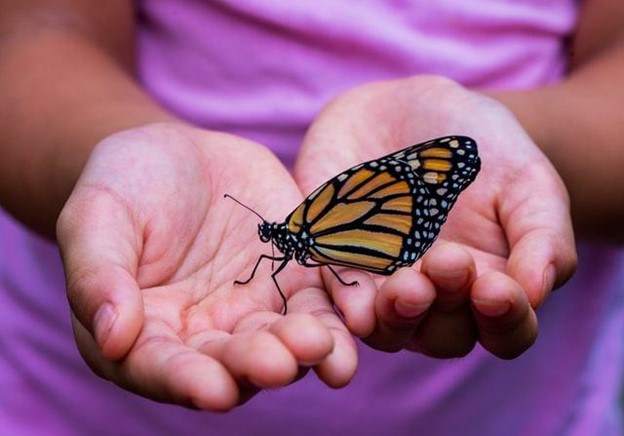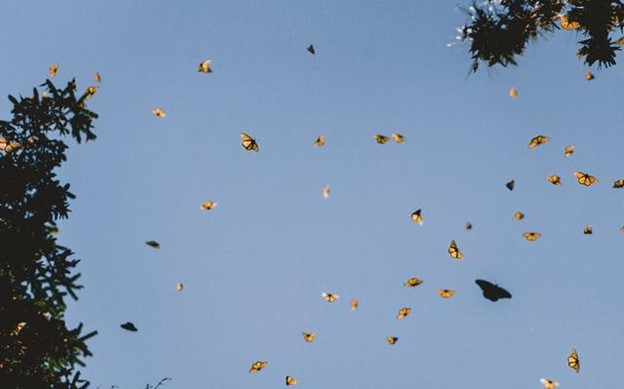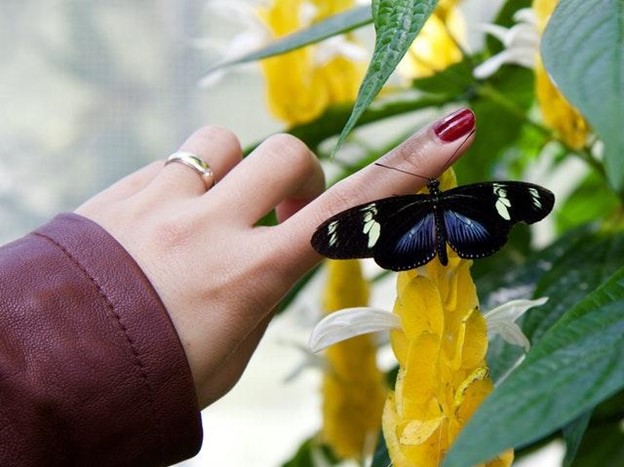A Tribute To The Monarch Butterfly: How to Turn Your Backyard Into a Butterfly Sanctuary.
Iconic is the most appropriate word to describe the Monarch butterfly. Most of us have fond childhood memories of the unmistakable orange and black beauty flitting around the blue sky on sunny summer days. They were everywhere — and their presence was so magnificent. Their name, in Greek, means “sleepy transformation” in recognition of their ability to hibernate and metamorphize — and if you’ve ever watched it happen through a glass jar, you understand why. Continue reading to learn about how to make a tribute to the Monarch butterfly.
If you’ve been feeling like you don’t see as many Monarch butterflies as you remember seeing 5, 10, or 20 years ago, you’re not imagining things. Loss of habitat, along with pesticides and the eradication of the Monarch butterfly’s host plant (Milkweed), has resulted in Monarch butterflies becoming endangered.
When we hear about an endangered species, it’s hard not to feel helpless and insignificant. But, unlike with many endangered species, you — yes, you! — hold real power to make a positive difference in protecting the Monarch butterfly and helping their populations thrive right in your own backyard. Here are some easy ideas to get you started. Let’s make a positive difference together!
How to attract and keep Monarchs in your butterfly garden
Helping Monarch butterflies to thrive in your garden requires some basic knowledge of their life cycle and migration paths, so that you know how to support them through these two journeys they take in their lifetime. You will also need some ideas for garden layouts and plants they love.
The Monarch butterfly life cycle
- The Monarch life cycle begins when the female Monarch butterfly lays her eggs individually on separate milkweed leaves.
- A few days later, the eggs hatch into the larva stage, which gives us the Monarch caterpillar.
- The Monarch caterpillar needs to grow as much as possible in the next two weeks, so it feasts on the only thing it eats — milkweed.
- Fully fed for the next phase of its life, the caterpillar enters the pupa stage by hanging upside down from a plant stem and spinning a protective chrysalis around itself.
- A couple of weeks later, the caterpillar emerges from the cocoon as a fully-formed, adult Monarch butterfly.
- If it isn’t time to migrate, adult butterflies immediately begin the Monarch life cycle again — that is, after they find a meal of nectar from pollinator plants nearby.
This is where you come in. So, let’s get our hands dirty and learn how to create a butterfly-friendly garden!
Plant milkweed
Grow milkweed for the Monarch butterflies and Monarch caterpillars to eat, and they will come. Plant milkweed in full sun, in groups of at least six plants, or those hungry, hungry caterpillars will run out of food. Water your plants sufficiently so they stay healthy. That is how they will produce sufficient nectar, for all those amazing butterflies that will start to visit your garden. Also:
- Avoid the use of pesticides and opt for natural solutions when possible.
- Provide landing pads near water sources so the butterflies can drink safely (mud puddles are ideal, since they allow the butterflies to get necessary minerals from the soil, too.)
- Create safe spaces for the butterflies to roost at night, like trees and shrubs
- Position large, flat rocks in the sun so that the butterflies can warm themselves in order to be able to fly again
- Trim plants carefully — there might be a life cycle in progress under a leaf!
- Avoid using peat-based compost.
- Go the extra mile, and register your garden as a Monarch Waystation.
Types of milkweed to plant — and other plants Monarchs love
Here is just a handful of the many plants that will attract butterflies and other pollinators to your garden.
- The types of milkweed Monarch butterflies love best include swamp milkweed, showy milkweed, tropical milkweed, and butterfly milkweed.
- Nectar plants they enjoy include joe pye weed, Mexican sunflower ‘torch’, butterfly bushes, and buddleja buzz.
- Pollinator plants they feed on include native wildflowers that will do well in the soil and sunlight conditions in your garden.
- For the Western U.S., check out these planting resources for more ideas about what to plant.
Blueprint for a Butterfly Garden
When considering the physical space and layout of a butterfly garden, there are some essential ideas and necessary steps one need to take to help the butterflies thrive successfully:
- Consider the physical space that you have at your disposal, and plan a design that works for your garden.
- Designate space for wild disarray. Dead foliage on the ground and tall, wild grasses are a favorite hibernating spot for some caterpillars and pupae.
- Plan for sunny areas and partially shaded areas so that the butterflies can be warm enough to fly without overheating and becoming dehydrated.
- Research what kind of conditions and planting practices will promote optimal growth for nectar/pollinator plants in your region.
- Create spaces for every phase of butterfly life: trees to roost in, plants to feed on, water to drink, and densely planted areas where a caterpillar could hang a chrysalis largely undetected by predators.
Mighty Tiny Migrators
One of nature’s most curious phenomena is the Monarch butterfly migration. Each fall, a very special group of Monarchs is born with the ability and purpose to live for up to six months so they can complete the migration south. Why is that so special? Well, the adult Monarch butterfly’s life span is typically only two to six weeks. It takes three to four successive generations to complete the migration back up north.
Another way you can help the Monarch population is by understanding and supporting their migration journey. Here’s a wee crash course on migration information:
Migration Paths
Monarch butterflies fall into three distinct populations that follow different migration paths across the United States:
- In Southern Florida, the Monarch population does not migrate.
- The Monarch population west of the Rockies migrates each fall from Western Canada to the coast of California near San Diego and Santa Cruz to spend the winter.
- East of the Rocky Mountains, the Monarchs migrate in the fall by several different paths originating in central and Eastern Canada and the Northeastern United States.
All three populations’ migration paths merge over Central Texas, and the entire group continues its migration together to central Mexico, where they spend the winter in the mountains in Oyamel fir forests.
This incredible journey south is completed in just one generation.
Migration Dates
The Monarch’s time of migration each year depends on the temperature outside and the length of the days, but goes roughly like this:
- August 18-30: The peak Monarch sightings at the 49th parallel coincide with the start of their journey south.
- November 10-22: The majority of the Monarch population is seen in overwintering locations.
- March: The first generation to migrate north begins, but they won’t arrive at their most northern destination until the fourth generation in late July or early August.
How to support the Monarch migration journey
Since their migration takes multiple generations, it is crucial that Monarch butterflies be able to complete their life cycle multiple times all over the United States. By using our tips to build a butterfly garden and ensuring abundant access to nectar and milkweed, you are supporting these amazing little migrators — no matter where you live!
Specific Monarch migration information and tracking based on milkweed habitats is actively mapped by The Western Monarch Milkweed Mapper Organization actively maps the Monarch migration based on sightings and milkweed habitats. You can help their cause by reporting sightings of Monarchs and milkweed.
Other butterflies of the United States you might attract to your garden
Of the approximate 17,500 butterfly species worldwide, the U.S. is home to a whopping 750 species. Most of those species fall into six overarching Families. Here’s how to recognize them in your garden:
Hesperiidae (Skippers)
The most common butterfly family in the United States is the Hesperiidae family with 200 species — known as “Skippers” based on their erratic flight patterns. Skippers are physically distinguished from other butterflies with their hooked antennae and the unique patterns of veins in their wings.
Lycaenidae (Blues and Hairstreaks)
A small and colorful family. Brownish Elfins appear in the spring. Coppers are abundant In open marshes and meadows. Hairstreaks boast delicate hairlike extensions on their hind wings. The Pygmy Blue of the West is the smallest butterfly in the U.S. and comes from the Blues species — the smallest species of this family.
Nymphalidae (Brush-footed Butterflies)
Encompassing several “sub” families of butterflies — Danaidae, Heliconiinae, Libytheidae, and Satridae — this family has talent. Fritillary Butterflies stand out with silver spots. The Mourning Cloak is one of few butterflies with the ability to overwinter, thanks to body chemicals that behave like antifreeze. The Viceroy and our beloved Monarch both evade predators by tasting bad.
Papilionidae (Swallowtails)
While there are 600 Swallowtail species across the world, fewer than 30 species reside in the United States. They are relatively large and colorful, and most have tails on their hindwings (hence the Family’s name).
Pieridae (Whites and Sulphurs and Yellows)
With just 60 species in the U.S. of 1100 worldwide, the Whites, Sulphurs, and Yellows mid-sized butterflies are aptly named: being yellow or white in color, with some having orange tips or greenish marbling on their wings. The most common U.S. butterfly — the Cabbage White — comes from this family.
Riodinidae (Metalmarks)
Metalmark butterflies are small and usually have rust-toned wings. Approximately 12 species live in the U.S., while there are over 1,000 Metalmark species worldwide.
What you can plant to attract endangered butterflies
By planting the host plants for these endangered butterflies, you can take action to protect U.S. butterflies for future generations. This list is far from exhaustive, but it’ll get you started.
- Karner blue butterfly → Wild lupine plant
- Callippe silverspot butterfly → Johnny-jump-on plant
- Bartram’s hairstreak butterfly → Pineland croton plant
- Saint Francis’ Satyr → Grasses, sedges, and rushes in wet, muddy, meadow-like ground
- San Bruno elfin butterfly → Sedum spathulifolium plant
- Schaus swallowtail → Torchwood and Wild Lime plants
- Palos verdes blue butterfly → Milkvetch and deerweed
- Florida leafwing butterfly → Pineland croton
- Uncompahgre fritillary butterfly → Snow willows
Butterflies: A gift that gives and gives
Monarchs and other butterflies give back to our gardens, to other wildlife, and to us humans. How do these painted-winged creatures benefit your garden? Here’s just a few ways:
- The diversity of a Monarch habitat attracts other pollinators, supporting the resilience of the ecosystem and its food chain.
- High-quality plants that attract butterflies also make excellent habitats for wild birds and waterfowl.
- Native Monarch plants are deep-rooted, which means they protect against soil erosion and improve water filtration — and they’re sturdy, drought-tolerant, and bring lots of colors and cheer to your garden.
- Monarchs are pollinators and their habitat attracts other pollinators, too — all of which are essential to our maintaining our diverse food supply. As pollinators become at risk, our food system will become more and more limited.
- More pollinators mean more plant growth, which in turn cleans the air, improves soil quality and combats carbon emissions.
- As we become more urbanized, naturally beautiful green spaces are key to help us all maintain physical and emotional health and well-being. Natural garden spaces also provide ways to engage with the environment for leisure, exercise, and education.
- We would also like to mention that this activity will provide the perfect time to have family bonding with a spouse, children, and extended family. If this is done as a community endeavor, it can create some community bonding as well.
Monarch butterflies are a gift to all of us. Their population decline will impact us negatively and, in some ways, devastatingly so. By honoring these tiny yet magical beautiful members of our local and national ecosystems, we will reap the rewards for generations to come. If you have any questions about how to create a tribute to the Monarch butterfly, contact us today at Caregogi!




